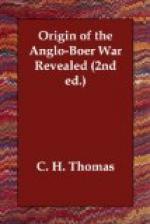About thirty odd years ago the Orange Free State and Transvaal were still swarming with all sorts of game. Venison was the staple diet. Lions and leopards also infested those States, but these and the game have been pretty well extirpated since, except in some of the lower parts of the Transvaal. In the earlier days ammunition was costly and hard to procure, and the use had to be husbanded accordingly. It became thus a practice never to pull a trigger unless with intense aim and the certainty of an effective shot. A man would go out stalking for an hour or so with perhaps but one or two charges, and would rarely fail in bringing home the kind of game wanted—either a springbock, blesbock, or wildebeest (gnu). In hunting lions, the lads would form part of the company for the purpose of being taught. The boys would learn that if a lion meant to attack he would approach to within twenty or thirty yards, and then straighten himself up before making the final charge. It was during that short halt that the disabling or killing shot would have to be delivered. Father and son would then be standing ready—the son to fire first; if unsuccessful, the animal would be brought down by the father. If there were a larger party and the lions numerous, the lessons would be learnt so much better by way of emulation. The boys soon realized that a lion, means business only when he advances silently and with smoothed gait, but that bristling up and roaring is a sure prelude to his skulking off. What we read of the terror-inspiring roar is to the Boer stripling pure romance and non-sense; but what he does realize is that he must hit the animal in a vital spot at the right moment or else run the risk of being clawed and bitten. The confidence, however, which he has in his gun gives him all the requisite nerve, and mishaps are of very rare occurrence. Those lion hunts used to be very profitable, not only for the valuable skins, but especially when a number of young cubs were also caught, which would realize considerably high prices from menagerie purveyors.
At the age of about eight years a boy would be taught to ride on horseback; when twelve years old he would be an expert horseman and a deadly rifle shot as well; at sixteen he would be able to perform all farm duties and rank with pride and confidence as an efficient burgher to take the field against any enemy. His brain is not addled with school lore, but is thoroughly versed and taught from nature’s book. Hardened to the fatigue of long rides over unfamiliar country in search of stray cattle, the Boer youth has often to subsist upon a bit of dried biltong (junked beef or venison), endure at intervals scorching heat and drenching rains, swim rivers, and pass the night with a stone for a pillow and his saddle as the only shelter, while his horse, securely hobbled, feeds upon the grass around. Never will he lose his way; if landmarks fail him and clouds hide moon and stars, he is guided by wind, the run of water or his horse’s instincts. Accustomed to wide horizons, he can promptly distinguish objects at a distance, which, to an ordinarily good eyesight, would need careful scanning through a field-glass.




